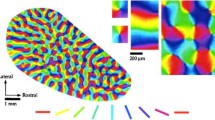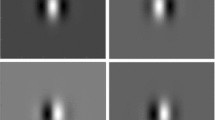Abstract
We demonstrate that the map of the preferred orientations and the corresponding map of the orientation tuning strengths as measured with optical imaging are not independent, but that band-pass filtering of the preferred orientation map at each location yields a good approximation of the orientation tuning strength. Band-pass filtering is performed by convolving the map of orientation preference with its own autocorrelation function. We suggest an interpretation of the autocorrelation function of the preferred orientations as synaptic coupling function, i.e., synaptic strength as a function of intracortical distance between cortical cells. In developmental models it has been shown previously that a “Mexican hat”-shaped synaptic coupling function (with a shape similar to that of the autocorrelation function) can produce a realistical-looking pattern of preferred orientations. Since optical imaging performs surface averaging, we discuss the possibility that the connection between the two maps is a measurement artifact of optical imaging. Whether this is the case can only be decided by combining electrode penetrations with optical imaging techniques for which we suggest experiments. We present a model for the generation of both maps from a single computational concept. The model is based on inverse Fourier transform of rather simple two-dimensional annulus-shaped spectra which will produce a column structure very similar to real data. Thus, our approach shows that the complex appearance of cortical orientation columns has a rather simple description in the Fourier domain. Our theoretical analysis explains why singularities in the cortex do not have vorticities other than ±1/2, a result which corresponds to recent experimental findings. This study combines the results from several modeling approaches with recently available optical imaging data to construct a model of both aspects (angle and strength) of the cortical orientation column system. This could alter ideas about cortical development if the link between the two maps can be established as a physiological result.
Similar content being viewed by others
References
Albus K (1975) A quantitative study of the projection area of the central and the paracentral visual field in area 17 of the cat. II. The spatial organization of the orientation domain. Exp Brain Res 24:159–179
Batschelet E (1981) Circular statistics in biology. Academic Press, New York
Bauer R, Dow BM (1991) Local and global principles of striate cortical organization: an advanced model. Biol Cybern 64:477–483
Baxter WT, Dow BM (1989) Horizontal organization of orientation-sensitive cells in primate visual cortex. Biol Cybern 61:171–182
Blasdel GG (1992a) Differential imaging of ocular dominance and orientation selectivity in monkey striate cortex. J Neurosci 12:3115–3138
Blasdel GG (1992b) Orientation selectivity preference and continuity in monkey striate cortex. J Neurosci 12:3139–3161
Blasdel GG, Salama G (1986) Voltage-sensitive dyes reveal a modular organization in monkey stria'te cortex. Nature 321:579–585
Bonhoeffer T, Grinvald A (1991) Iso-orientation domains in cat visual cortex are arranged in pinwheel like patterns. Nature 353:429–431
Bracewell RN (1986) The Fourier transform and its applications. Academic Press, London
Braitenberg V (1985) Charting the visual cortex. In: Peters A, Jones EG (eds) Cerebral cortex, vol 3. Plenum, New York, pp. 379–414
Braitenberg V, Braitenberg C (1979) Geometry of orientation columns in the visual cortex. Biol Cybern 33:179–186
Chapman B, Zahs KR, Stryker MP (1991) Relation of cortical cell orientation selectivity to alignment of receptive fields of geniculocortical afferents that arborize within a single orientation column in ferret visual cortex. J Neurosci 11:1347–1358
Cooper LN, Fishel Liberman, Oja E (1979) A theory for the acquisition and loss of neuron specificity in visual cortex. Biol Cybern 33:9–28
Diao YC, Jia WG, Swindale NV, Cynader MS (1990) Functional organization of the cortical 17/18 border region. Exp Brain Res 79:271–282
Durbin R, Mitchison G (1990) A dimension reduction framework for understanding cortical maps. Nature 343:644–647
Edwards DP, Kaplan E (1992) How sharp is the orientation tuning of single cells in the cytochrome-oxidase blobs of primate visual cortex (abstract). Invest Ophthalmol 33:1255
Elsdale R, Wasoff F (1976) Fibroblast cultures and dermatoglyphics: the topology of two planar patterns. Wilhelm Roux Arch Entwick-lungsmech Org 180:121–147
Ferster D (1987) Origin of orientation-selective EPSPs in simple cells of cat visual cortex. J Neurosci 7:1780–1791
Frostig RD, Lieke EE, Ts'o DY, Grinvald A (1990) Cortical functional architecture and local coupling between neuronal activity and the microcirculation revealed by in vivo high-resolution optical imaging of intrinsic signals. Proc Natl Acad Sci USA 87:6082–6086
Götz G (1987) Do “d-Blob” and “l-Blob” hypercolumns tessellate the monkey visual cortex? Biol Cybern 56:107–109
Götz G (1988) Cortical templates for the self-organization of orientation-specific d- and l-hypercolumns in monkeys and cats. Biol Cybern 58:213–223
Grinvald A, Lieke E, Frostig RD, Gilbert CD, Wiesel TN (1986) Functional architecture of cortex revealed by optical imaging of intrinsic signals. Nature 324:361–364
Hata Y, Tsumoto T, Sato H, Hagihara K, Tamura H (1988) Inhibition contributes to orientation selectivity in visual cortex of cat. Nature 335:815–817
Hess R, Negishi K, Creutzfeldt O (1975) The horizontal spread of intracortical inhibition in the visual cortex. Exp Brain Res 22:415–419
Hubel DH, Wiesel TN (1962) Receptive fields binocular interaction and functional architecture in the cat's visual cortex. J Physiol (Lond) 160:106–154
Hubel DH, Wiesel TN (1963) Shape and arrangement of columns in the cat's striate cortex. J Physiol (Lond) 165:559–568
Hubel DH, Wiesel TN (1968) Receptive fields and functional architecture of monkey striate cortex. J Physiol (Lond) 195:215–243
Hubel DH, Wiesel TN (1974) Sequence regularity and geometry of orientation columns in the monkey striate cortex. J Comp Neurol 158:267–243
Hubel DH, Wiesel TN, Stryker MP (1978) Anatomical demonstration of orientation columns in macaque monkey. J Comp Neurol 177:361–380
Humphrey AL, Norton TT (1980) Topographic organization of the orientation column system in the striate cortex of the tree shrew (Tupaia glis) I. Microelectrode recording. J Comp Neurol 192:531–547
Kohonen T (1990) The self-organizing map. Proc IEEE 78:1464–1480
Lee BB, Albus K, Heggelund P, Hulme MJ, Creutzfeldt OD (1977) The depth distribution of optimal stimulus orientations for neurones in cat area 17. Exp Brain Res 27:301–314
Legendy CR (1978) Cortical columns and the tendency of neighboring neurons to act similarly. Brain Res 158:89–105
Linsker R (1986a) From basic network principles to neural architecture: emergence of orientation-selective cells. Proc Natl Acad Sci USA 83:8390–8394
Linsker R (1986b) From basic network principles to neural architecture: Emergence of orientation columns. Proc Natl Acad Sci USA 83:8779–8783
Malsburg C von der, (1973) Self-organization of orientation sensitive cells in the striate cortex. Kybernetik: 14:85–100
Malsburg C von der, Cowan JD (1982) Outline of a theory for the ontogenesis of iso-orientation domains in visual cortex. Biol Cybern 45:49–56
Miller KD (1990) Cortical organization of orientation selectivity emerges from interactions between ON- and OFF-center inputs. Soc Neurosci Abstr 16:798
Miller KD (1992) Development of orientation columns via competition between ON- and OFF-center inputs. NeuroReport 3:73–76
Nass MM, Cooper LN (1975) A theory for the development of feature detecting cells in visual cortex. Biol Cybern 19:1–18
Niebur E, Wörgötter F (1990) Circular inhibition: a new concept in long-range interactions in the mammalian visual cortex. In: Proceedings of the International Joint Conference on Neural Networks — San Diego'90. IEEE, Piscataway, New Jersey, II-367–11–372
Obermayer K, Ritter H, Schulten K (1990) A principle for the formation of the spatial structure of cortical feature maps. Proc Natl Acad Sci USA 87:8345–8349
Obermayer K, Blasdel GG, Schulten K (1991) A neural network model for the formation and for the spatial structure of retinotopic maps orientation- and ocular dominance columns. In: Kohonen T (eds) Artificial neural networks I. North-Holland, Amsterdam, pp 505–511
Orban GA (1984) Neuronal operations in the visual cortex. (Studies of brain function 11) Springer, Berlin Heidelberg New York
Perez R, Glass L, Shlaer R (1975) Development of specificity in the cat visual cortex. J Math Biol 1:275–288
Rojer AS, Schwartz EL (1990) Cat and monkey cortical columnar patterns modeled by bandpass-filtered 2 D white noise. Biol Cybern 62:381–391
Soodak RE (1987) The retinal ganglion cell mosaic defines orientation columns in striate cortex. Proc Natl Acad Sci USA 84:3936–3940
Swindale NV (1982) A model for the formation of orientation columns. Proc R. Soc London 215:211–230
Swindale NV (1985) Iso-orientation domains and their relationship with cytochrome oxidase patches. In: Rose D, Dobson VG (eds) Models of the visual cortex. Wiley, New York, pp 452–472
Swindale NV (1992) A model for the coordinated development of columnar systems in primate striate cortex. Biol Cybern 66:217–230
Swindale NV, Matsubara JA, Cynader MS (1987) Surface organization of orientation and direction selectivity in cat area 18. J Neurosci 7:1414–1427
Szentagothai J (1975) The module concept in cerebral cortex architecture. Brain Res 95:475–496
Toyama K, Kimura M, Tanaka K (1981a) Cross-correlation analysis of interneuronal connectivity in cat visual cortex. J Neurophysiol 46:191–201
Toyama K, Kimura M, Tanaka K (1981b) Organization of cat visual cortex as investigated by cross-correlation technique. J Neurophysiol 46:202–214
Ts'o DY, Frostig RD, Lieke EE, Grinvald A (1990) Functional organization of primate visual cortex revealed by high resolution optical imaging. Science 249:333–348
Wörgötter F, Eysel UT (1991) Topographical aspects of excitatory and inhibitory intracortical interactions contributing to orientation specificity in cat visual cortex. Eur J Neurosci 3:1232–1244
Wörgötter F, Niebur E (1992) Generation of direction selectivity by isotropic intracortical connections. Neural Comp 4:332–340
Wörgötter F, Niebur E, Koch C (1990) Modeling visual cortex: hidden anisotropies in an isotropic inhibitory connection scheme. In: Eckmiller R (ed) Advanced neural computers. Elsevier, Amsterdam, pp 87–95
Wörgötter F, Niebur E, Koch C (1991) Isotropic connections generate functional asymmetrical behavior in visual cortical cells. J Neurophysiol 66:444–459
Author information
Authors and Affiliations
Rights and permissions
About this article
Cite this article
Wörgötter, F., Niebur, E. Cortical column design: a link between the maps of preferred orientation and orientation tuning strength?. Biol. Cybern. 70, 1–13 (1993). https://doi.org/10.1007/BF00202561
Received:
Accepted:
Issue Date:
DOI: https://doi.org/10.1007/BF00202561




